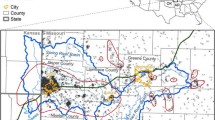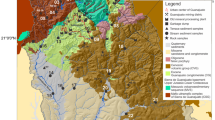Abstract
The United States town of Aurora, Missouri, USA, stockpiled lead (Pb) and zinc (Zn) mining wastes from the early to mid-1900s in the form of chat piles. Clean-up actions were undertaken at intervals in subsequent years including land leveling and removal of chat. This study assessed the current state of contamination by identifying areas where metals are present at toxic levels. For this purpose, stream sediment samples (N = 100) were collected over a 9 × 12 km area in and around Aurora. Their content of cadmium (Cd), Pb, and Zn were measured, and concentration maps were generated using ArcGIS to categorize affected areas. Metal concentrations varied over a wide range of values with the overall highest values observed in the north-northeast part of Aurora where abundant chat piles had been present. Comparison between observed concentrations and sediment-quality guidelines put the contaminated areas mentioned are above-toxic levels for Cd, Pb and Zn. In contrast, levels in rural areas and the southern part of Aurora were at background levels, thus posing no threat to aquatic habitats. The fact that contamination is constrained to a relatively small area can be advantageously used to implement further remediation and, by doing so, to help protect the underlying karst aquifer.






Similar content being viewed by others
References
Allert AL, DiStefano RJ, Schmitt CJ, Fairchild JF, Brumbaugh WG (2012) Effects of mining-derived metals on riffle-dwelling crayfish in southwestern Missouri and southeastern Kansas, USA. Arch Environ Contam Toxicol 63:563–573
Andrews WJ, Becker MF, Mashburn SL, Smith J (2009) Selected metals in sediments and streams in the Oklahoma part of the Tri-State Mining District, 2000–2006. USGS Survey Scientific Investigations Report 2009–5032
Antunes IMHR, Albuquerque MTD, Sanches FAN (2014) Spatial risk assessment related to abandoned mining activities, an environmental management tool. Environ Earth Sci 72:2631–2641
Astete J, Caceres W, Gastanaga MC, Lucero M, Sabastizagal I, Oblitas T et al (2009) Lead intoxication and other health problems in children population who live near mine tailing. Rev Peru Med Exp Salud Publica 26:15–19
Besser JM, Brumbaugh WG, Allert AL, Poulton BC, Schmitt CJ, Ingersoll CG (2009) Ecological impacts of lead mining on Ozark streams: toxicity of sediment. Ecotoxicol Environ Saf 72:516–526
Besser JM, Ingersoll CG, Brumbaugh WG, Kremble NE, May TW, Wang N et al (2014) Toxicity of sediments from lead-zinc mining areas to juvenile freshwater mussels (Lampsilis siliquoidea) compared to standard test organisms. Environ Toxicol Chem 34:626–639
Beyer WN, Dalgarn J, Dudding S, French JB, Mateo R, Miesner J et al (2004) Zinc and lead poisoning in wild birds in the Tri-State Mining District. Environ Contam Toxicol 48:108–117
Bétourney MC (2009) Abandoned metal mine stability risk evaluation. Risk Anal 29:1355–1370
Boussen S, Soubrand M, Bril H, Ouerfelli K, Abdeljaouad S (2013) Transfer of lead, zinc and cadmium from mine tailings to wheat (Triticum aestivum) in carbonated Mediterranean (Northern Tunisia) soils. Geoderma 192:227–236
Brockie DC, Hare EH, Dingess PR (1968) The geology and ore deposits of the Tri-State District of Missouri, Kansas and Oklahoma. In: Ridge JD (ed) Ore deposits of the United States, 1933–1967. The American Institute of Mining, Metallurgical, and Petroleum Engineers, New York, pp 400–443
Carbone N, Blodgett C, Muenks S, Lea R, Franson R (2007) Evaluation of hyperspectral imagery for Missouri Mine Waste Inventory Sept. 1, 2006—June 30, 2007. Missouri Department of Natural Resources and U.S. Environmental Protection Agency Brownfields Program
Carlson JL (1999) Zinc mining contamination and sedimentation rates of historical overbank deposits, Honey Creek watershed, southwest Missouri. Master thesis, Missouri State University
Daldoul G, Souissi R, Souissi F, Jemmali N, Chakroun HK (2015) Assessment and mobility of heavy metals in carbonated soils contaminated by old mine tailings in North Tunisia. J African Earth Sci 110:150–159
Förstner U (2004) Traceability of sediment analysis. Trends Anal Chem 23:217–236
Gibson AM (1972) Wilderness bonanza—the Tri-State District of Missouri, Kansas, and Oklahoma. University of Oklahoma Press, Norman
Gutierrez M, Wu SS, Peebles JL (2015) Geochemical mapping of Pb- and Zn-contaminated streambed sediments in southwest Missouri, USA. J Soil Sediment 15:189–197
Hudson-Edwards KA, Jamieson HE, Lottermoser BG (2011) Mine wastes: past, present, future. Elements 7:375–380
Imes JL (1989) Analysis of the effect of pumping on ground-water flow in the Springfield Plateau and Ozark aquifers near Springfield, Missouri. USGS-WRI, Open File Report 89–4079, Rolla, MO
Ingersoll CG, Ivey CD, Brumbaugh WG, Besser JM, Kremble NE (2009) Toxicity assessment of sediments from the Grand Lake O’ the Cherokees with the amphipod Hyalella azteca. US Geological Survey Administrative Report CERC-8335-FY09-20-01
Jacob DL, Otte ML (2004) Long-term effects of submergence and wetland vegetation on metals in a 90-year old abandoned Pb-Zn mine tailings pond. Environ Pollut 130:337–345
Johnson AW, Gutierrez M, Gouzie D, McAlily LR (2016) State of remediation and metal toxicity in the Tri-State Mining District, USA. Chemosphere 144:1132–1141
Juracek KE (2013) Occurrence and variability of mining-related lead and zinc in the spring river flood plain and tributary flood plains, Cherokee County, Kansas, 2009–11. USGS Scientific Investigations Report 2013–5028
Kubit OE, Pluhar CJ, De Graff JV (2015) A model for prioritizing sites and reclamation methods at abandoned mines. Environ Earth Sci 73:7915–7931
Leach DL (1994) Genesis of the Ozark Mississippi valley-type metallogenic province, Missouri, Arkansas, Kansas, and Oklahoma, USA. In: Fontbote L, Boni M (eds) Sediment-hosted Zn-Pb ores. Special publication of the society for geology applied to mineral deposits, vol. 10. Springer, Berlin, pp 104–38
MacDonald DD, Ingersoll CG, Berger TA (2000) Development and evaluation of consensus-based sediment quality guidelines for freshwater ecosystems. Arch Environ Contam Toxicol 39:20–31
MacDonald DD, Ingersoll CG, Crawford M, Prencipe H, Besser JM, Brumbaugh WG et al. (2010) Advanced screening-level ecological risk assessment (SLERA) for aquatic habitats within the Tri-State Mining District, Oklahoma, Kansas and Missouri. Draft Final Technical Report submitted to the United States Environmental Protection Agency, Region 6, Dallas Texas, Region 7, Kansas City Kansas and the United States Fish and Wildlife Service, Columbia
McCarthy TS (2011) The impact of acid mine drainage in South Africa. S African J Sci 107:1–7
Missouri Department of Natural Resources (2013) Baldwin Park. In Registry of confirmed abandoned or uncontrolled hazardous waste disposal sites in Missouri. Missouri Registry annual report, pp 199–202. http://www.dnr.mo.gov/pubs/pub337.pdf. Accessed:
Missouri Department of Natural Resources (2015) GeoSTRAT—Geosciences Technical Resource Assessment Tool. http://dnr.mo.gov/geology/geostrat.htm. Accessed 9 Nov 2015
Nikolaidis C, Zafiriadis I, Mathioudakis V, Const T (2010) Heavy metal pollution associated with an abandoned lead–zinc mine in the Kirki region, NE Greece. Bull Environ Contam Toxicol 85:307–312
Park DUK, Kim DS, Yu SD et al (2014) Blood levels of cadmium and lead in residents near abandoned metal mine areas in Korea. Environ Monit Assess 186:5209–5220
Paul AP, NV Paretti, DE MacCoy, AMD Brasher (2012) The occurrence of trace elements in bed sediment collected from areas of varying land use and potential effects on stream macroinvertebrates in the conterminous western United States, Alaska, and Hawaii, 1992–2000. USGS Scientific Investigations Report 2012–5272
Pope LM (2005) Assessment of contaminated streambed sediment in the Kansas part of the historic Tri-State Lead and Zinc Mining District, Cherokee County, 2004. USGS Survey Scientific Investigations Report 2005–5251. http://pubs.usgs.gov/sir/2005/5251/pdf/SIR20055251.pdf
Richards JM, Mugel DN (2008) Potentiometric surface of the Ozark Aquifer near Springfield, Missouri, 2006–07. USGS Scientific Investigations Map 3003
Romero FM, Armienta MA, González-Hernández G (2007) Solid-phase control on the mobility of potentially toxic elements in an abandoned lead/zinc mine tailings impoundment, Taxco, Mexico. Appl Geochem 22:109–127
Schaider LA, Senn DB, Estes ER, Brabander DJ, Shine JP (2014) Sources and fates of heavy metals in a mining-impacted stream: temporal variability and the role of iron oxides. Sci Total Environ 490:456–466
Schmitt CJ, Whyle JJ, Brumbaugh WG, Tillitt DE (2005) Biochemical effects of lead, zinc, and cadmium from mining on fish in the tri-states district of northeastern Oklahoma, USA. Environ Toxicol Chem 24:1483–1495
Trimble JC (2001) Spatial patterns and floodplain contributions of mining-related contaminants in Chat Creek watershed, southwest Missouri, MS Thesis, Missouri State University
United States Environmental Protection Agency (2004) The incidence and severity of sediment, contamination in surface waters of the United States. National Sediment Quality Survey (2nd ed). Report EPA-823-R-04-007
Wills BA, Finch JA (2016) Tailings disposal. In: Wills’ mineral processing technology: An introduction to the practical aspects of ore treatment and mineral recovery (8th ed). pp 439–448
Yanqun Z, Yuan L, Jianjun C, Hauyan C, Li Q, Schvartz C (2005) Hyperaccumulation of Pb, Zn and Cd in herbaceous grown on lead-zinc mining area in Yunnan, China. Environ Int 31:755–762
Acknowledgments
This study was funded by a Missouri State University faculty research Grant.
Author information
Authors and Affiliations
Corresponding author
Rights and permissions
About this article
Cite this article
Gutiérrez, M., Wu, SS., Rodriguez, J.R. et al. Assessing the State of Contamination in a Historic Mining Town Using Sediment Chemistry. Arch Environ Contam Toxicol 70, 747–756 (2016). https://doi.org/10.1007/s00244-016-0265-9
Received:
Accepted:
Published:
Issue Date:
DOI: https://doi.org/10.1007/s00244-016-0265-9




